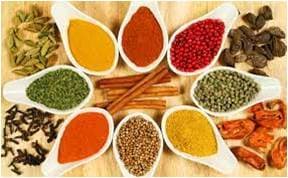Indian Spices with Surprising Health Benefits

Dr. Chirag Sethi* and Dr. Swarna Anchal**
*Director, Classic Fitness Academy, New Delhi
**Technical Writer, Classic Fitness Academy, New Delhi
Introduction
Export of Indian spices was enormous during last year at the time of coronavirus pandemic. The demand for immunity-boosting spices has increased tremendously. Many of the spices are proven not only immunity booster but also to have other health benefits. From ancient times, our great grandparents were aware of the health benefits of spices, and the knowledge was passed down to descendants. Till today, we use various spices as the first line of health care.
Plants are known for various life-saving functions for humans and animals by providing food and oxygen that is vital for life. Different parts of plants such as seeds, fruits, bark, roots, and other plant parts are used as flavoring agents for food. The Indian subcontinent is known for a variety of spices grown in different climates in different parts of the country. The person who's grown up in an Indian household knows the magic of spices in foods and as medicine. Spices can be used in different forms such as whole, chopped, ground, roasted, fried, and topping. Spices are blended with food to extract the nutrients and bind them in a palatable form. There are more than 40 Indian spices used in combination or alone to enhance the taste of food products and for maximum health benefits.
Many of these spices have bioactive components that have medicinal values. Apart from this, spices also have religious and cosmetic importance. In this article, we will discuss the various spices, their bioactive components, and health benefits.
(1)Turmeric (Haldi)
Scientific Name: Curcuma longa
Plant Part to use: Roots
Bioactive component: Curcumin
Indian food needs turmeric as it is a ground spice and has an earthy supporting flavor. It is used as a coloring and flavoring agent for food. In many types of research it is reported that for health purposes, it must be used with black pepper in your recipes. Turmeric has a great anti-inflammatory effect, but without the piperine from black pepper, its effects are not up to the mark. Apart from this, it enhances the anti-oxidative capacity of the body also. Turmeric is also known for enhancing skin quality and reducing dark spots from the skin.
(2)Cumin (Jira)
Scientific Name: Cuminum cyminum
Plant Part to use: Seeds
Bioactive component: Cuminaldehyde, cymene, and terpenoids
It is used as a spice for its distinctive flavor and aroma and generally is best when used whole, and fried in oil at the beginning of a dish. The Health benefits of cumin as reported are anti-oxidative properties, help to reduce weight, lower cholesterol, and control blood sugar.
(3)Green Cardamom (Cchoti Ilayachi)
Scientific Name: Elettaria cardamomum
Plant Part to use: Seeds
Bioactive component: Terpenes, Flavonoids
The small amount is enough for flavoring due to its strong aroma. Green cardamom is specially used for tea and special aroma in curries and desserts. It is having antioxidant and diuretic properties that may lower bloodpressure. Green cardamom has cancer-fighting compounds and helps with Digestive Problems, Including Ulcers. It is used to treat bad breath and prevent cavities.
(4)Coriander (Sukha Dhaiya)
Scientific Name: Coriandrum sativum
Plant Part to use: Dried Seeds
Bioactive component: anthocyanins, flavonoids
This seed has an aroma like citrus mixed with some leafy, woody notes, and is used in many dishes. It is grounded into powder just before adding to a curry for maximum flavor. Coriander has significant anti-inflammatory, hypoglycemic, and hypocholesterolemic potential. Alongside, it is also effective in mitigating gastrointestinal complications.
(5)Ginger (Adarek)
Scientific Name: Zingiber officinale
Plant Part to use: Stem
Bioactive component: Gingerol
Ginger is an essential ingredient for most curries as, without ginger-garlic paste, they will not be complete. Ginger helps alleviate nausea and vomiting resulting from chemotherapy or pregnancy. It is having an anti-inflammatory effect, and improving digestive function. Ginger and honey are used in combination for treating cold and cough.
(1)Garlic (Lahasun)
Scientific Name: Allium sativum
Plant Part to use: Stem
Bioactive component: Allicin
Garlic enhances the flavor of curries tremendously as its bioactive components have sulfur in them. Using 4 to 10 garlic cloves gives a good hearty garlic flavor. Garlic is very helpful in lowering blood pressure, improves good cholesterol levels thus reduces the risks for heart health. Drinking the milk (2 cups) early morning by boiling 4-5 garlic cloves in it until it remains one cup has been proved beneficial for the heart. Garlic is also good for bone health, acts as a blood purifier, and is used for treating infections.
(2) Asafoetida (Hing)
Scientific Name: Ferula asafetida
Plant Part to use: Dried latex exuded from root
Bioactive component: Tannins and Flavonoids
It is one of the favorite Indian spices. It exhibits anti-oxidative and anti-inflammatory effects. Along with them, it is very good for digestion and irritable bowel syndrome (IBS). It is having antimicrobial and antifungal properties also. While storing it make sure to store it in a sealed container to prevent loss of aroma.
(3) Fenugreek (Methi)
Scientific Name: Trigonella foenum-graecum
Plant Part to use: Seeds and leaves
Bioactive component: Coumarin and Alkaloids compounds
One of the important Indian spices is Fenugreek. Fenugreek seeds are pretty bitter but have significant health benefits. The leaves are also used in various recipes and are less prone to bitterness. Fenugreek seeds also have many health benefits. It reduces the risk of diabetes and helps in weight loss. It improves milk production and flows in females while in males it raises testosterone and boosts sperm count. Fenugreek seeds reduce inflammation and are a great pain reliever.
(4) Cinnamon/Cassia Bark (Dalachini)
Scientific Name: Cinnamomum verum
Plant Part to use: Bark
Bioactive component: Cinnamaldehyde, Cinnamate, and Cinnamic acid
Cinnamon is loaded with antioxidants such as polyphenols and has anti-inflammatory properties to repair tissue damage. It also helps in reducing LDL cholesterol which is bad for the heart. Cinnamon is proved to increase sensitivity to the hormone insulin and also help in losing weight.
(5) Carom (Ajwain)
Scientific Name: Trachyspermum ammi
Plant Part to use: Seeds
Bioactive component: phenols and flavonoids
Each tiny carom fruit has a huge amount of thymol in it and giving a strong aroma. It provides instant relief from indigestion and acidity. Apart from it carom seeds have antibacterial and antifungal properties and are widely used for ear and toothaches. Carom seeds are proved to lower bad blood cholesterol and blood pressure. They prevent coughing and improve airflow.
(6) Cloves (Lavang)
Scientific Name: Syzygium aromaticum
Plant Part to use: Flower buds
Bioactive component: Eugenol
Cloves are high in antioxidants ad have antimicrobial properties. Like carom seeds, they are also used in-ear and toothaches. It improves liver and bone health. It also helps in reducing ulcers.
(7) Black Pepper (Kali Mirch)
Scientific Name: Piper nigrum
Plant Part to use: Seeds
Bioactive component: Piperine
Black pepper is high in anti-oxidative and anti-inflammatory properties. It also controls blood sugar levels and blood pressure. Apart from these, it helps in the absorption of nutrients, promotes gut health, offers pain relief, and reduces apatite.
Conclusions
Spices are a very important part of Indian foods even it will not be an exaggeration if we say spices as ‘soul of Indian cuisines’. If spices are consumed in moderation you can derive health benefits, but an overdose of any spice can leads to severe health risks such as indigestion or even ulcers. All the spices have specific bioactive components which provide specific aroma and health beneficial properties. Major health benefits include lowering blood pressure and cholesterol. They control sugar levels in the blood. Most of the spices are having anti-oxidative and anti-inflammatory activities also. Many spices are proven in having anti-cancerous properties also but still much more yet to be known in this area. So to conclude, spices are our little health caretaker from the kitchen.
References
1) Shan B, Cai YZ, Sun M, Corke H (2005) Antioxidant capacity of 26 spice extracts and characterization of their phenolic constituents. Journal of Agriculture and Food Chemistry 53(20):7749-59.
2) Rao PV and Gan SH (2014) Cinnamon: A Multifaceted Medicinal Plant.Evidence-Based Complementary Alternative Medicine 642942.
3) Khan A, Safdar M, Khan MMA, Khattak KN, Anderson RA (2003) Cinnamon improves glucose and lipids of people with type 2 diabetes. Diabetes Care 26(12):3215-8.
4) Adisakwattana S, Lerdsuwankij O, Poputtachai U, Minipun A, Suparpprom C (2011) Inhibitory activity of cinnamon bark species and their combination effect with acarbose against intestinal α-glucosidase and pancreatic α-amylase. Plant Foods for Human Nutrition 66(2):143-8.
5) Nagpal M and Sood S (2013)Role of curcumin in systemic and oral health: An overview. Journal of Natural Science Biology and Medicine 4(1): 3–7.
6) Menon VP and Sudheer AR (2007) Antioxidant and anti-inflammatory properties of curcumin. Advances in Experimental Medicine and Biology 595:105-25.
7) Borrelli F, Capasso R, Aviello G, Pittler MH, Izzo AA (2005) Effectiveness and safety of ginger in the treatment of pregnancy-induced nausea and vomiting. Obstetrics and Gynecology 105(4):849-56.
8) Ernst E and Pittler MH (2000) Efficacy of ginger for nausea and vomiting: a systematic review of randomized clinical trials British Journal of Anesthesia 84(3):367-71.






